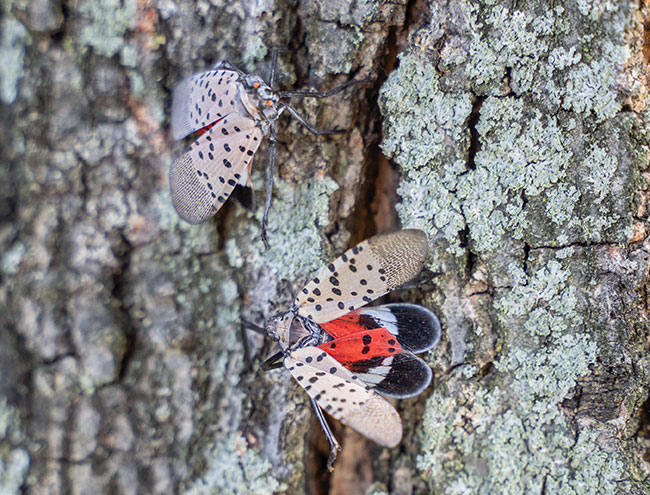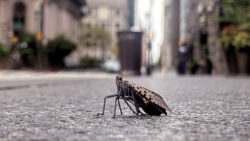
Features
Don’t let this invasive species take over your greenhouse
CFIA on lookout for spotted lanternfly.
May 9, 2023 By Alice Sinia
 While no potted lanternfly have been found alive in the country yet, there have been hundreds of adults found near the U.S.-Canadian border.
While no potted lanternfly have been found alive in the country yet, there have been hundreds of adults found near the U.S.-Canadian border. The Canadian Food Inspection Agency has tasked Canadians with helping protect the country’s vineyards and fruit orchards from the spotted lanternfly (SLF). These invasive insects are plant sap-sucking, destructive to plants they feed on and have the potential to cause millions of dollars in damage. While none have been found alive in the country yet, there have been hundreds of adults found near the U.S.-Canadian border.
The SLF is native to Asia and was introduced to the U.S. in 2014 when the insects were detected in eastern Pennsylvania. They have since spread across many other states and are known to feed on over 70 plant species.
This is concerning for the agriculture industry, especially viniculture and greenhouse workers and managers, whose main priorities involve caring for and growing plants and tending to the ones already thriving in the environment. They also need to regulate the internal conditions within greenhouses to ensure the plants have the best environment conducive for growing.
How to spot an SLF
Spotted lanternfly adults are distinctive in appearance, easily recognized; are approximately 1-inch (25 mm) long and 1/2-inch (12mm) wide at rest. The front wings are light brownish with distinctive black dots at the front and black streaks towards the tip. The underwing is bright red which can be seen through the forewings or when fully spread. Early immature stages are black with white dots while older stages have red spots intermingled with patches of black and white spots. The egg masses are easy to spot, too, are grayish with waxy covering and about 25mm wide. SLF are easy to see during the day since they cluster near the base of plants they feed on.
 This planthopper feeds on important agricultural and landscape plants including nursery plants, fruit trees and grape vines, and it uses its mouthparts to puncture into and feed on trees and plants. Although its preferred host is the tree of heaven, it will feed on other plants including multiflora rose, cultivated roses, Virginia creeper and the veins of leaves on trees such as maples, cherry, black walnut, willow and birch.
This planthopper feeds on important agricultural and landscape plants including nursery plants, fruit trees and grape vines, and it uses its mouthparts to puncture into and feed on trees and plants. Although its preferred host is the tree of heaven, it will feed on other plants including multiflora rose, cultivated roses, Virginia creeper and the veins of leaves on trees such as maples, cherry, black walnut, willow and birch.
Signs of an infestation
From late Spring to early Fall, watch for a sudden increased influx of bees and/or wasps due to honeydew attraction as this may be an indication that SLF’s are infesting the plants or crops. Other signs include:
- Finding egg masses on plants and other surfaces.
- Wounded and bleeding trees i.e. visible sap flowing from trees due to SLF feeding.
- Plants that appear to be distressed by the curling of leaves or by decreased production of fruit.
- Accumulation of honeydew, a sugary excrement produced by spotted lanternflies as they feed, that can grow sooty mold and attract pests such as ants.
- Congregation or swarming of adults at base of host tree or infested trees.
How to prevent an infestation in your greenhouse
Spotted lanternflies feed on the sap of trees and a handful of other plants. During the feeding process they can excrete a substance called honeydew. This substance can start to cover greenhouse surfaces and can start growing black sooty mold. Spotted lanternflies can also become a nuisance to greenhouses because of the sheer number that can appear and infest the environment. The biggest threat these pests pose is to the agricultural industry where they have been shown to cause extensive problems to grape growers. Here are some tips on how you can stop a SLF takeover:
- Eliminate eggs: Eliminating spotted lanternfly eggs is one of the most effective ways to control this pest. Late Fall is a good time to look for and remove egg masses on trees, tree trunks, branches, rocks, yard furniture, exterior wall surfaces, sheds and objects/equipment/machinery stored outside. Whenever egg masses are seen on your trees and/or plants, scrape off the egg mass into a bag or container filled with rubbing alcohol or hand sanitizer. Egg masses that are scraped to the ground without being collected and destroyed may still hatch, so it is important to be certain they have been destroyed.
- Limit host trees: Limit the spread of tree of heaven plants. This Chinese greenery is a common weed tree and contains chemicals that make the SLF bad-tasting and inedible, giving them natural protection from predators. Young seedlings may be pulled or dug up; however, be sure to remove all roots and plant fragments. Also, tree injection with an approved herbicide is effective when applied during the summer months.
- Gain control before adulthood: Controlling the SLF while they’re nymphs is most effective if done from late April through early November. You can do this by tree banding using a sticky board or paper wrapped around the trunk of trees or plants to capture the insects as they climb on the plants or trees. Remove, dispose and replace the stick bands regularly to ensure effectiveness. Also, using special treatments and sprays that are specifically labeled for SLF control will help.
- Inspect plants: Thoroughly look over trees and plants for signs of this pest, particularly at dusk and at night when these insects tend to gather in large groups on tree trunks or stems of plants. If you need to transport items into the greenhouse from another location, be sure to inspect the plants entering the area. It’s also important to scan the cars and vehicles transporting plants, including the wheels, wells and underside where egg masses can be laid hidden from view.
These tips will help you in taking the first steps in identifying and combatting spotted lanternflies. However, the best defense against this pest in your greenhouse, or any facility, is to call a pest expert who can help you identify the culprits and offer the best resolution for treatment.
Alice Sinia is a quality assurance manager for regulatory/lab services for Orkin Canada.
Print this page